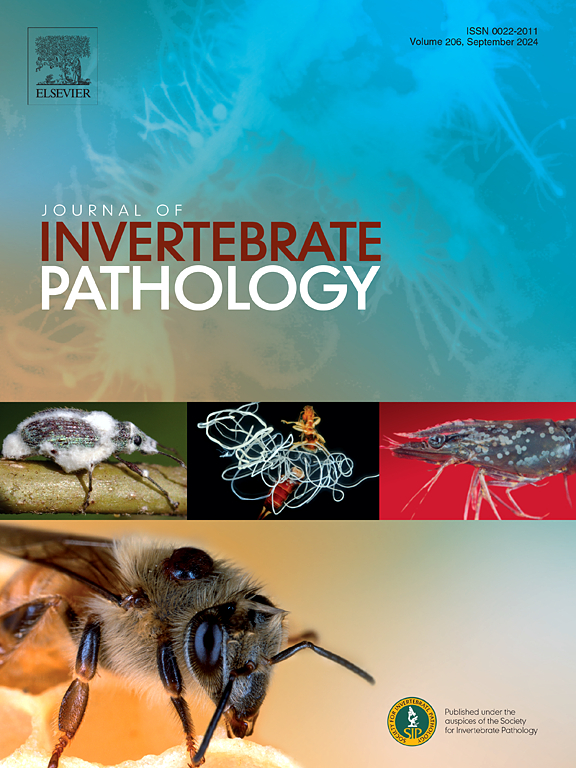Characteristics of vhvp-2 gene distribution and diversity within the Vibrio causing translucent post-larvae disease (TPD)
IF 2.4
3区 生物学
Q1 ZOOLOGY
引用次数: 0
Abstract
Translucent post-larva vibriosis (VTPD) in Penaeus vannamei, caused by the virulence factor Vibrio high virulent protein 2 (vhvp-2) gene, poses a significant threat to the shrimp aquaculture industry in China. This study conducted a comprehensive analysis of the vhvp-2 gene distribution and genetic diversity among Vibrio, which play a key role in the pathogenesis of translucent post-larvae disease (TPD). A total of 6281 Vibrio genomes from the NCBI database were screened, revealing the presence of the vhvp-2 gene in 26 strains, predominantly in V. parahaemolyticus, with diverse locations on both plasmids and chromosomes. Comparative analysis of the genomes, plasmids, and the vhvp-2 gene successfully differentiated three distinct clusters of Vibrio species and identified at least two major plasmid groups. However, these plasmid groups did not exhibit the same evolutionary relationships as the host bacteria themselves. The analysis also revealed the conserved presence of the vhvp-2 gene along with genetic variations. Moreover, the widespread presence of antimicrobial resistance genes (ARGs) and virulence factors in Vibrio strains enhances their pathogenicity and poses increased public health risks. The findings underscore the importance of understanding the adaptability, evolution, and ecological characteristics of Vibrio strains harboring vhvp-2 gene. This research provides a scientific foundation for the development of effective disease prevention and control strategies, contributing to the mitigation of TPD’s impact on the shrimp aquaculture industry and supporting its sustainable and healthy growth.
vhvp-2基因在引起半透明后幼虫病(TPD)的弧菌中的分布特点和多样性。
由高致病性弧菌蛋白 2(vhvp-2)基因引起的万年青对虾半透明幼体后弧菌病(VTPD)对我国对虾养殖业构成了严重威胁。本研究全面分析了在透亮后幼体病(TPD)发病机制中起关键作用的 vhvp-2 基因在弧菌中的分布和遗传多样性。研究人员从 NCBI 数据库中筛选了 6281 个弧菌基因组,发现 26 个菌株中存在 vhvp-2 基因,主要存在于副溶血性弧菌中,其在质粒和染色体上的位置各不相同。通过对基因组、质粒和 vhvp-2 基因进行比较分析,成功区分出三个不同的弧菌群,并确定了至少两个主要质粒群。然而,这些质粒群并没有表现出与宿主细菌本身相同的进化关系。分析还揭示了 vhvp-2 基因的保守存在以及基因变异。此外,弧菌菌株中抗菌药耐药性基因(ARGs)和毒力因子的广泛存在增强了它们的致病性,增加了公共卫生风险。这些发现强调了了解携带 vhvp-2 基因的弧菌菌株的适应性、进化和生态特征的重要性。这项研究为制定有效的疾病防控策略提供了科学依据,有助于减轻TPD对对虾养殖业的影响,支持其可持续健康发展。
本文章由计算机程序翻译,如有差异,请以英文原文为准。
求助全文
约1分钟内获得全文
求助全文
来源期刊
CiteScore
6.10
自引率
5.90%
发文量
94
审稿时长
1 months
期刊介绍:
The Journal of Invertebrate Pathology presents original research articles and notes on the induction and pathogenesis of diseases of invertebrates, including the suppression of diseases in beneficial species, and the use of diseases in controlling undesirable species. In addition, the journal publishes the results of physiological, morphological, genetic, immunological and ecological studies as related to the etiologic agents of diseases of invertebrates.
The Journal of Invertebrate Pathology is the adopted journal of the Society for Invertebrate Pathology, and is available to SIP members at a special reduced price.

 求助内容:
求助内容: 应助结果提醒方式:
应助结果提醒方式:


